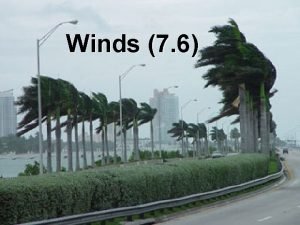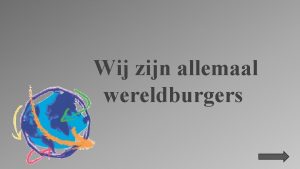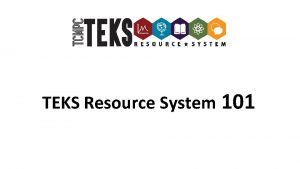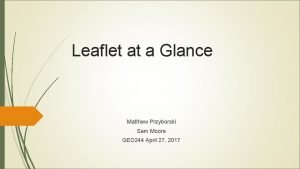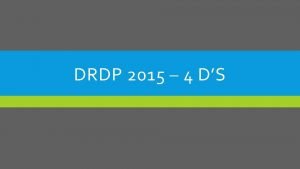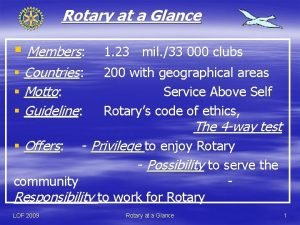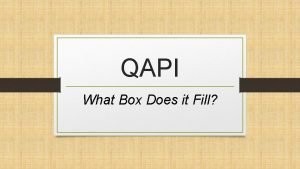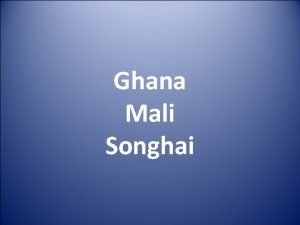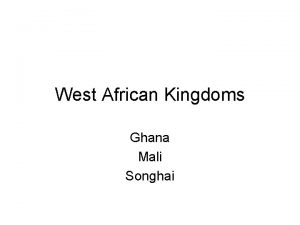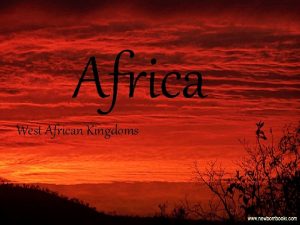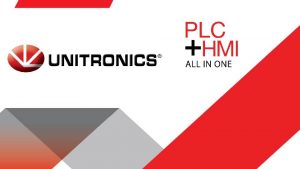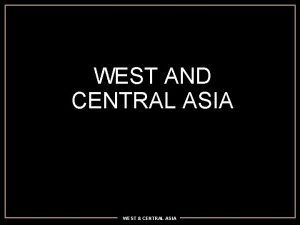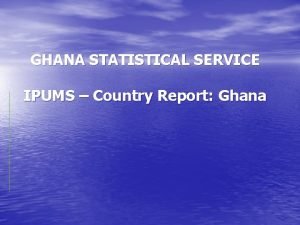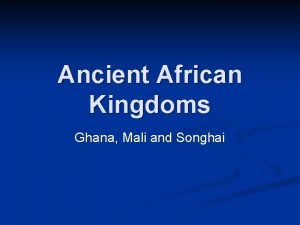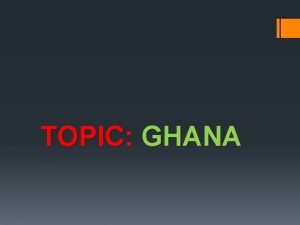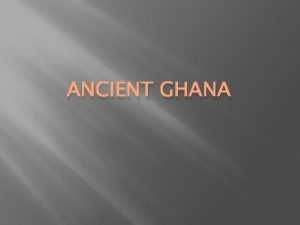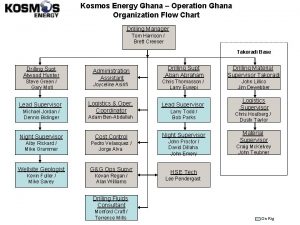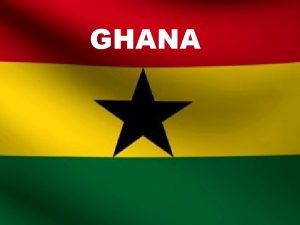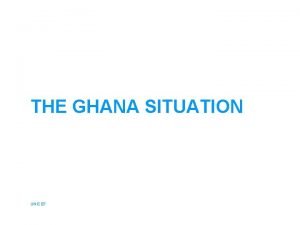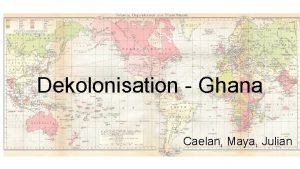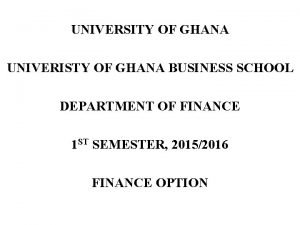GHANA AT A GLANCE Ghana is a West



















- Slides: 19

GHANA AT A GLANCE Ghana is a West African country bordering the North Atlantic Ocean between Cote d’Ivoire and Togo. It has a total area of 238, 540 km 2 and a population of about twenty (20) million. In comparison with the United States, Ghana is slightly smaller than the State of Oregon. CAPITAL: Accra GOVERNMENT: There has been a constitutional democracy since 1992. There is political stability irrespective of changing governments. Ghana is the only nation in the sub-region to have one democratically elected government to take over peacefully from another democratically elected government. There is rule of law and the three arms of government, I. e. the Executive, Judiciary and Legislature are independent and serve as checks and balances on each other.

LOCATION MAP

CLIMATE: Tropical, warm and comparatively dry along southeast coast; hot and humid in southwest; hot and dry in the north. LANGUAGE: English (official); African languages, including Akan, Moshi-Dagbani, Ewe and Ga. ECONOMY: Ghana has an open economy and an attractive predictable fiscal structure for competitive rates of return. The macro-economic environment is very stable. Inflation and lending rates have dropped over the past two (2) years. Inflation is expected to reach single digit by the year 2004. The consequent drop in domestic interest rates will enable expansion of/and establishing of new business to employ the large number of unemployed labour. Discipline in government expenditure has been a major contributor to the improvement in the macro-economic indications of the country.

To resuscitate the economy of the country, the Government of Ghana has embraced the HIPIC initiative of the World Bank.

COMPANY HISTORY The Ghana National Petroleum Corporation (GNPC) is a state-owned corporation established in 1983 by PNDC Law 64, but started operation in 1985. The functions of GNPC are to explore, develop, produce and dispose of petroleum. GNPC has been restructured into a more compact entity focused in the medium term on promoting and facilitating investments in hydrocarbon exploration and exploitation in Ghana. The Corporation is also to support oil companies undertaking oil and gas exploration and exploitation in the country. The Corporation’s new mission, vision, values and key corporate objectives are: MISSION The mission of GNPC is to promote, explore and develop the hydrocarbon resources of the nation through lean, efficient and technology-driven investments to enhance the economic development of Ghana.

VISION The vision of GNPC is to be a world-class corporation capable of making Ghana the fastest growing destination for upstream petroleum investments in West Africa and to put the nation on the map of self-sufficient oil producing countries. A Ghana that is vibrant and prosperous and fuelled by its own hydrocarbon resources. VALUES The core values of GNPC are professionalism, respect for talent, reward of merit and encouragement of teamwork. The Corporation also encourages and rewards creativity and innovation. GNPC is committed to self-discipline and to the protection of Ghana’s interest.

KEY CORPORATE OBJECTIVES Ø To achieve at least half a billion dollars in upstream foreign direct capital investments by the year 2007; Ø To attain an output of 20, 000 barrels of crude oil equivalent per day (representing about 50% of the country’s current oil imports) by the year 2007; Ø To upgrade the skills of all staff in the key areas of operations to industry level of competence by the year 2005; Ø To reduce the time taken for licensing acreage from an average of twelve (12) months to three (3) months by December 2004. Promoting the hydrocarbon potential of Ghana, GNPC and the Government of Ghana have signed Petroleum Agreements with five (5) foreign oil companies who have their origins either in the UK or USA. These companies have their acreage in the offshore sedimentary basins of Ghana has 105, 000 km 2 of onshore sedimentary basins and about 52, 000 km 2 of offshore sedimentary basins; about 60% of this is deepwater.

Currently, about 33, 000 km 2 of the offshore basins are under licence to four (4) oil and gas exploration companies. These companies are: § Devon Energy Company § Vanco Energy Company § Alderney Energy Resources § Dana Petroleum plc In addition, a Petroleum Development and Production Agreement has been signed with Tano Energy Company for the development of the Tano Fields. The gas produced from these fields is expected to be piped to shore to power gas turbines mounted on a barge to generate about 125 mw of electricity.



CURRENT EXPLORATION ACTIVITIES A lot of seismic activity has gone on in the sedimentary basins of Ghana with a total of about 70, 000 km of 2 -D data and about 5, 500 km 2 of 3 -D data acquired both onshore and offshore. Western Tano Basin Dana Petroleum is a UK company based in Aberdeen, Scotland. They have acquired acreage in offshore Tano Basin. The Agreement was signed in March 1997 and they have drilled one offshore exploratory well, which resulted in the discovery of heavy oil in Upper Cretaceous channel sands. Deepwater Accra-Keta Basin Devon Energy commenced operations in Ghana in 1997 as Santa Fe Energy. They have previously drilled one well and acquired two vintages of 3 -D seismic and about 1, 728 km of 2 -D seismic. Devon has signed a new Petroleum exploration and Production Agreement, which covers exclusively deepwater offshore Keta basin.

Deepwater Tano-Cape Three Points Vanco Energy Company has acquired about 10, 000 km 2 of acreage offshore Tano-Cape Three Points Basin. They are scheduled to acquire approximately 2, 800 km of 2 -D seismic to be followed by about 300 km 2 of 3 -D survey over one of the numerous deepwater prospects so far identified. Offshore Saltpond Basin A UK based independent, Alderney Energy Resources has acquired about 6, 000 km 2 acreage of the offshore Saltpond Basin just south of the Saltpond Field. DEVELOPMENT AND PRODUCTION ACTIVITIES Tano Fields The Tano fields development has been awarded to a subsidiary of First Oil Plc, Tano energy Company. The Company is expected to start production at a rate of 6, 000 bopd and 26 mmcfd.

Saltpond Field Redevelopment Negotiations will soon be finalised for a company to redevelop the Saltpond oil and gas fields. It would be recalled that the Saltpond Field was produced from 1978 – 1985. At its peak it was producing 4, 800 bopd. The field has substantial reserves remaining. OPEN ACREAGE About 18, 000 km 2 of the offshore blocks and the whole of the onshore Tano and Keta basins are still open. In addition to this, the large onshore Voltaian Basin is open. The Voltaian Basin, which is about 103, 000 km 2 is largely unexplored. To date, only 230 km of reconnaissance seismic data have been acquired in a small area around Atebubu in the Brong Ahafo Region. Shell Petroleum drilled one exploration well near Premuase, also in the Brong Ahafo Region in 1977. Despite clear indications of hydrocarbon generation in that basin, evidenced by the fact that the Premuase

Well encountered dead oil, and that water wells drilled by the Russians in the 1960 s in the Northern Region encountered oil stains and also bitumen impregnations found in the limestone deposits, the basin has not seen any meaningful exploration activity. POTENTIAL As stated earlier, Ghana has a good potential for commercial production of hydrocarbons (oil and gas). Analysis of the exploration history of the country indicates that 75% of all the wells drilled have encountered hydrocarbons (generally known as technical discoveries). Four (4) marginal oil and gas fields, Saltpond, North and South Tano, West Tano and one gas field, Cape Three Points, have been discovered so far. The Saltpond Field was produced for seven (7) years while a number of appraisal wells have been drilled in the South Tano Field. GNPC and the oil companies have undertaken extensive acquisition, processing and interpretation of new seismic data. Also,

A significant amount of old data has been reprocessed and re-interpreted, in addition to a number of geological and engineering studies being undertaken as a means of re-evaluating some of the basins in which discoveries have been made. A number of potential hydrocarbon bearing structures and prospects have been mapped. Over sixty (60) prospects and leads have been mapped with potential reserves ranging from 40 MMBO to 1. 2 BBO. These are by no means the total number of prospects, because as further evaluations are done, and as new technologies like 3 -D seismic are applied, we believe additional prospects will be unearthed. These discoveries and prospects have been the basis of GNPC’s promotional activities, which have been aimed at attracting international companies to invest in the petroleum potential of Ghana.


FISCAL REGIME Petroleum exploration and production in Ghana is governed by three complementary laws. 1. The GNPC Law – PNDCL. 64 of 1982 2. The Petroleum Exploration and Production Law – PNDCL. 84 of 1984 3. The Petroleum Income Tax Law – PNDCL. 188 of 1987 These three laws have been synthesized into the Model Petroleum Agreement, which serves as the basic negotiating document of GNPC/Government. The key terms include: 1. Negotiable Royalty (normally between 5% - 12%) 2. Income Tax normally set at 35%

3. Negotiable GNPC Participation, a part of which is Carried 4. Negotiable additional Oil Entitlements (AOEs) 5. Capital Allowance (Depreciation) – 20% CONCLUSION The Government’s objective is to create the right environment to attract more oil companies to invest in the open acreage. Although the terms and conditions in the existing Petroleum law and the Petroleum Income tax Law are generally good, the Government and GNPC are prepared to make them even more attractive.

For further information, please contact: M. O. Boateng Managing Director G. N. P. C. Private Mail bag Tema, GHANA Tel: 233 -22 -204726 Fax: 233 -22 -202854 E-mail: cegnpc@ghana. com Nii Adzei-Akpor Exploration Manager G. N. P. C. Private Mail Bag Tema, GHANA Tel: 233 -22 -202124 Fax: 233 -22 -202854 E-mail: xplognpc@ghana. com Thomas Manu Director, Operations G. N. P. C. Private Mail Bag Tema, GHANA Tel: 233 -22 -202843 Fax: 233 -22 -202854 E-mail: xplognpc@ghana. com
 What is the horizontal movement of air called
What is the horizontal movement of air called Old west vs new west
Old west vs new west What creates wind
What creates wind Zuid west noord oost
Zuid west noord oost East is east and west is west
East is east and west is west Parliamentary procedure at a glance
Parliamentary procedure at a glance Tcmpc
Tcmpc Compared to shy glance vigee
Compared to shy glance vigee Hinduism at a glance
Hinduism at a glance At a glance leaflet
At a glance leaflet Education at a glance 2015
Education at a glance 2015 Christianity at a glance
Christianity at a glance Glance guest setup.exe
Glance guest setup.exe Drdp at a glance
Drdp at a glance Rotary at a glance
Rotary at a glance Az eld standards
Az eld standards Drdp preschool measures at a glance
Drdp preschool measures at a glance Buddhism at a glance
Buddhism at a glance Language
Language What element of qapi addresses the culture of the facility
What element of qapi addresses the culture of the facility


